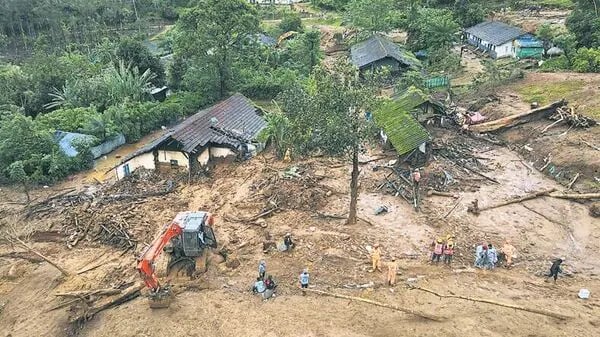ವಯನಾಡ್ ಭೂಕುಸಿತಕ್ಕೆ ಕಾರಣವಾದ ಹವಾಮಾನ ಬದಲಾವಣೆಯಿಂದಾಗಿ ಶೇಕಡಾ 10 ರಷ್ಟು ಭಾರೀ ಮಳೆಯಾಗಿದೆ ಎಂದು ವಿಜ್ಞಾನಿಗಳು ಹೇಳುತ್ತಾರೆ
ಹವಾಮಾನ ಬದಲಾವಣೆಯು ಮಳೆಯ ತೀವ್ರತೆಯಲ್ಲಿ ಶೇಕಡಾ 10 ರಷ್ಟು ಹೆಚ್ಚಳವನ್ನು ಉಂಟುಮಾಡಿದೆ ಎಂದು ಮಾದರಿಗಳು ಸೂಚಿಸುತ್ತವೆ ಎಂದು ಅವರು ಹೇಳಿದರು. ವಿಶ್ವ ಹವಾಮಾನ ಗುಣಲಕ್ಷಣ (WWA) ಗುಂಪಿನ ವಿಜ್ಞಾನಿಗಳ ಹೊಸ ಅಧ್ಯಯನದ ಪ್ರಕಾರ, ಕೇರಳದ ವಯನಾಡ್ಗೆ ಅಪ್ಪಳಿಸಿದ ವಿನಾಶಕಾರಿ ಭೂಕುಸಿತಗಳು ಹವಾಮಾನ ಬದಲಾವಣೆಯಿಂದಾಗಿ ಶೇಕಡಾ 10 ರಷ್ಟು ಹೆಚ್ಚು ತೀವ್ರವಾಗಿರುವ ನಿರಂತರ ಮಳೆಯಿಂದ ಪ್ರಚೋದಿಸಲ್ಪಟ್ಟವು.
Rohan kumar. K Collected Sources
9/10/20241 min read


ಹವಾಮಾನ ಬದಲಾವಣೆಯು ಮಳೆಯ ತೀವ್ರತೆಯಲ್ಲಿ ಶೇಕಡಾ 10 ರಷ್ಟು ಹೆಚ್ಚಳವನ್ನು ಉಂಟುಮಾಡಿದೆ ಎಂದು ಮಾದರಿಗಳು ಸೂಚಿಸುತ್ತವೆ ಎಂದು ಅವರು ಹೇಳಿದರು.
ವಿಶ್ವ ಹವಾಮಾನ ಗುಣಲಕ್ಷಣ (WWA) ಗುಂಪಿನ ವಿಜ್ಞಾನಿಗಳ ಹೊಸ ಅಧ್ಯಯನದ ಪ್ರಕಾರ, ಕೇರಳದ ವಯನಾಡ್ಗೆ ಅಪ್ಪಳಿಸಿದ ವಿನಾಶಕಾರಿ ಭೂಕುಸಿತಗಳು ಹವಾಮಾನ ಬದಲಾವಣೆಯಿಂದಾಗಿ ಶೇಕಡಾ 10 ರಷ್ಟು ಹೆಚ್ಚು ತೀವ್ರವಾಗಿರುವ ನಿರಂತರ ಮಳೆಯಿಂದ ಪ್ರಚೋದಿಸಲ್ಪಟ್ಟವು.
ಎರಡು ತಿಂಗಳ ಕಾಲ ಮುಂಗಾರು ಮಳೆಯಿಂದಾಗಿ ಹೆಚ್ಚು ನೆನೆಸಿದ ಮಣ್ಣಿನಲ್ಲಿ ಈ ಪ್ರದೇಶದಲ್ಲಿ ಒಂದೇ ದಿನದಲ್ಲಿ 140 ಮಿ.ಮೀ ಗಿಂತ ಹೆಚ್ಚು ಮಳೆ ದಾಖಲಾಗಿದೆ. ಇದು ವಿನಾಶಕಾರಿ ಭೂಕುಸಿತಗಳು ಮತ್ತು ಪ್ರವಾಹಗಳನ್ನು ಪ್ರಚೋದಿಸಿತು, ವಯನಾಡಿನಲ್ಲಿ ಕನಿಷ್ಠ 231 ಜೀವಗಳನ್ನು ಬಲಿ ತೆಗೆದುಕೊಂಡಿತು ಎಂದು ಸಂಶೋಧಕರು ಹೇಳಿದ್ದಾರೆ.
"ರಾಜ್ಯದಲ್ಲಿ ಅತಿ ಹೆಚ್ಚು ಭೂಕುಸಿತದ ಅಪಾಯವನ್ನು ಹೊಂದಿರುವ ವಯನಾಡಿನ ಪ್ರದೇಶದಲ್ಲಿ ಭೂಕುಸಿತವನ್ನು ಪ್ರಚೋದಿಸಿದ ಮಳೆಯು ಸಂಭವಿಸಿದೆ. ಹವಾಮಾನವು ಬೆಚ್ಚಗಾಗುತ್ತಿದ್ದಂತೆ ಇನ್ನೂ ಭಾರೀ ಮಳೆ ಬೀಳುವ ನಿರೀಕ್ಷೆಯಿದೆ, ಇದು ಉತ್ತರ ಕೇರಳದಲ್ಲಿ ಇದೇ ರೀತಿಯ ಭೂಕುಸಿತಗಳಿಗೆ ತಯಾರಿ ಮಾಡುವ ತುರ್ತುಸ್ಥಿತಿಯನ್ನು ಒತ್ತಿಹೇಳುತ್ತದೆ" ಎಂದು ಮಜಾ ವಾಲ್ಬರ್ಗ್ ಹೇಳಿದರು. , ರೆಡ್ ಕ್ರಾಸ್ ರೆಡ್ ಕ್ರೆಸೆಂಟ್ ಹವಾಮಾನ ಕೇಂದ್ರದಲ್ಲಿ ಹವಾಮಾನ ಅಪಾಯದ ಸಲಹೆಗಾರ.
ಭಾರತ, ಯುಎಸ್, ಯುಕೆ ಮತ್ತು ಸ್ವೀಡನ್ನ 24 ವಿಜ್ಞಾನಿಗಳ ತಂಡವು ಹವಾಮಾನ ಬದಲಾವಣೆಯ ಮೇಲೆ ಮಾನವರ ಪ್ರಭಾವವನ್ನು ಲೆಕ್ಕಾಚಾರ ಮಾಡಲು ವಯನಾಡ್ ಪ್ರದೇಶದಲ್ಲಿನ ಮಳೆಯ ಚಟುವಟಿಕೆಯನ್ನು ಪ್ರತಿಬಿಂಬಿಸಲು ಹೆಚ್ಚಿನ ರೆಸಲ್ಯೂಶನ್ಗಳೊಂದಿಗೆ ಹವಾಮಾನ ಮಾದರಿಗಳನ್ನು ಪರಿಶೀಲಿಸಿತು.
ಹವಾಮಾನ ಬದಲಾವಣೆಯು ಮಳೆಯ ತೀವ್ರತೆಯಲ್ಲಿ ಶೇಕಡಾ 10 ರಷ್ಟು ಹೆಚ್ಚಳವನ್ನು ಉಂಟುಮಾಡಿದೆ ಎಂದು ಮಾದರಿಗಳು ಸೂಚಿಸುತ್ತವೆ ಎಂದು ಅವರು ಹೇಳಿದರು. ವಿಶ್ವದ ಸರಾಸರಿ ತಾಪಮಾನದಲ್ಲಿ ಎರಡು ಡಿಗ್ರಿ ಸೆಲ್ಸಿಯಸ್ನಷ್ಟು ಏರಿಕೆಯಾದರೆ ಮಳೆಯ ತೀವ್ರತೆಯಲ್ಲಿ ಇನ್ನೂ ನಾಲ್ಕು ಶೇಕಡಾ ಹೆಚ್ಚಳವನ್ನು ಮಾದರಿಗಳು ಮುನ್ಸೂಚಿಸುತ್ತವೆ.
ಆದಾಗ್ಯೂ, ಅಧ್ಯಯನದ ಪ್ರದೇಶವು ಚಿಕ್ಕದಾಗಿದೆ ಮತ್ತು ಮಳೆ ಮತ್ತು ಹವಾಮಾನದ ಸಂಕೀರ್ಣ ಡೈನಾಮಿಕ್ಸ್ನೊಂದಿಗೆ ಪರ್ವತಮಯವಾಗಿರುವುದರಿಂದ "ಉನ್ನತ ಮಟ್ಟದ ಅನಿಶ್ಚಿತತೆ" ಸಂಶೋಧನಾ ಮಾದರಿಯ ಸುತ್ತ ಸುತ್ತುತ್ತದೆ.
ವಿಜ್ಞಾನಿಗಳ ಪ್ರಕಾರ, ಹವಾಮಾನವು ಬೆಚ್ಚಗಿರುತ್ತದೆ ಮತ್ತು ಬೆಚ್ಚಗಾಗುವುದರಿಂದ ಈ ತೀವ್ರತೆಯ ಘಟನೆಗಳು ಭಾರತ ಮತ್ತು ಪ್ರಪಂಚದ ಇತರ ಭಾಗಗಳಲ್ಲಿ ಹೆಚ್ಚು ಸಾಮಾನ್ಯವಾಗಬಹುದು. ಬೆಚ್ಚಗಿನ ತಾಪಮಾನದಲ್ಲಿ ಗಾಳಿಯು ಹೆಚ್ಚು ತೇವಾಂಶವನ್ನು ಹೊಂದಿರುತ್ತದೆ, ಇದು ಒಂದೇ ದಿನದಲ್ಲಿ ಅಂತಹ ಭಾರೀ ಮಳೆಗೆ ಕಾರಣವಾಗುತ್ತದೆ.
ಭಾರತೀಯ ಹವಾಮಾನ ಇಲಾಖೆಯು 1901 ರಲ್ಲಿ ದಾಖಲೆಗಳನ್ನು ಇಡಲು ಪ್ರಾರಂಭಿಸಿದ ನಂತರ ವಯನಾಡ್ ಭೂಕುಸಿತವು ಕೇರಳ ರಾಜ್ಯದಲ್ಲಿ ಮೂರನೇ ಅತ್ಯಂತ ತೀವ್ರವಾದ ಭೂಕುಸಿತವಾಗಿದೆ.
Scientists claim 10 per cent heavier rains due to climate change caused Wayanad landslides
The devastating landslides which struck Kerala's Wayanad were triggered by incessant rainfall which was 10 per cent more intense due to climate change, according to a new study by the scientists from the World Weather Attribution (WWA) group.The region recorded more than 140 mm of rain in a single day on highly soaked soils due to monsoon rainfall for two months. This triggered devastating landslides and floods claiming at least 231 lives in Wayanad, the researchers said.
"The rainfall that triggered the landslides occurred in a region of Wayanad that has the highest landslide risk in the state. Even heavier downpours are expected as the climate warms, which underscores the urgency to prepare for similar landslides in northern Kerala," said Maja Vahlberg, a climate risk consultant at the Red Cross Red Crescent Climate Centre.
The team of 24 scientists from India, the US, the UK, and Sweden examined climate models with high resolutions to reflect the rainfall activity in the Wayanad region for calculating the influence of humans on climate change.
The models suggest that climate change caused a 10 per cent increase in the intensity of the rainfall, they said. The models also forecast a further four per cent increase in the intensity of rainfall if there is a rise in the world's average temperature by two degrees Celsius.
However, a "high level of uncertainty" revolves around the research model as the region of study is small and mountainous with complicated dynamics of rainfall and climate.
According to scientists, events of this severity are likely to become more common in India and the rest of the world as the climate becomes warmer and warmer. In warmer temperatures air carries more moisture which leads to such heavy downpours in a single day.
Wayanad landslide was the third most intense in the state of Kerala since the Indian weather department started keeping records in 1901.
© 2024. All rights reserved.
Contact
9449143888
krishimithra@outlook.com


